分词短语作状语详细
- 格式:doc
- 大小:43.00 KB
- 文档页数:8
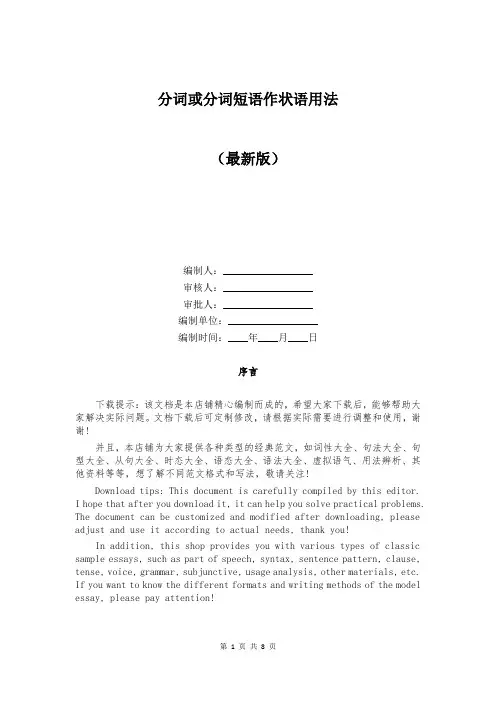
分词或分词短语作状语用法(最新版)编制人:__________________审核人:__________________审批人:__________________编制单位:__________________编制时间:____年____月____日序言下载提示:该文档是本店铺精心编制而成的,希望大家下载后,能够帮助大家解决实际问题。
文档下载后可定制修改,请根据实际需要进行调整和使用,谢谢!并且,本店铺为大家提供各种类型的经典范文,如词性大全、句法大全、句型大全、从句大全、时态大全、语态大全、语法大全、虚拟语气、用法辨析、其他资料等等,想了解不同范文格式和写法,敬请关注!Download tips: This document is carefully compiled by this editor.I hope that after you download it, it can help you solve practical problems. The document can be customized and modified after downloading, please adjust and use it according to actual needs, thank you!In addition, this shop provides you with various types of classic sample essays, such as part of speech, syntax, sentence pattern, clause, tense, voice, grammar, subjunctive, usage analysis, other materials, etc. If you want to know the different formats and writing methods of the model essay, please pay attention!分词或分词短语作状语用法㈠分词或分词短语作状语时,可以表示时间、原因、条件、让步(可转换成相应的状语从句)① Put into use in April 2000, the hotline was meant for residents reporting water and heating supply breakdowns.Put into use in April 2000 == When it was put into use in April 2000(时间状语)② Blamed for the breakdown of the school computer network, Alice was in low spirits.Blamed for the breakdown of the school computer network == Because she was blamed for the breakdown of the school computer network(原因状语)③ Given time, he'll make a fist-class tennis player.(条件状语)Given time == If he is given time④ Left at home, John didn't feel afraid at all.Left at home == Although he was left (让步状语)表示方式,伴随状况或结果(可以转换成并列句或非限制性定语从句)① We often provide our children with toys, footballs or basketballs, thinking that all children like these things.thinking that all children like these things.== and think that all children like these things.(伴随状语)② He earns a living driving a truck.driving a truck == by driving a truck. (方式状语)高考对分词用作方式状语考得③ He fired, killing one of the passers-by.He fired and killed one of the passers-by. (结果状语)④ He died, leaving his wife with five children.He died and left his wife with five children. (结果状语)⑤ It rained and rained, vehicles bogged and bridges washed out.It rained and rained, and vehicles were bogged and bridges were washed out. (结果状语)㈡有时为了强调,分词前会加when, while, if, unless, once, though, even if, as if 等连词一起作状语When comparing different cultures, we often pay attention only to the differences.Though tired, he still continued reading.Once published, this book will be popular with the students.㈢分词(短语) 与主语的关系主语一致:分词短语的动作由主句主语发出。

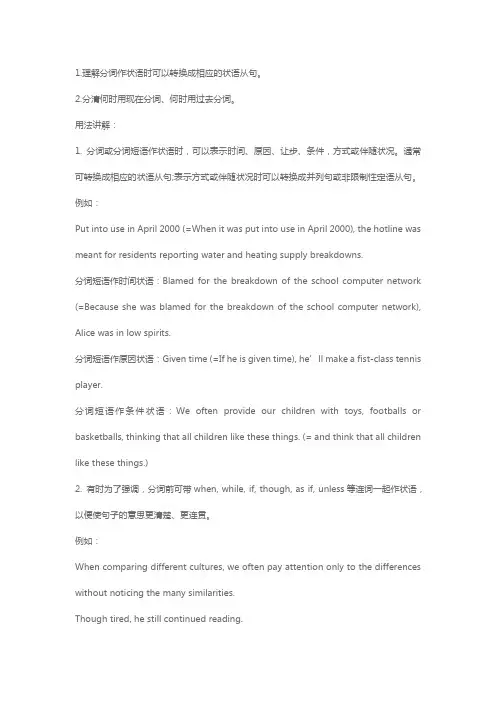
1.理解分词作状语时可以转换成相应的状语从句。
2.分清何时用现在分词、何时用过去分词。
用法讲解:1. 分词或分词短语作状语时,可以表示时间、原因、让步、条件,方式或伴随状况。
通常可转换成相应的状语从句;表示方式或伴随状况时可以转换成并列句或非限制性定语从句。
例如:Put into use in April 2000 (=When it was put into use in April 2000), the hotline was meant for residents reporting water and heating supply breakdowns.分词短语作时间状语:Blamed for the breakdown of the school computer network (=Because she was blamed for the breakdown of the school computer network), Alice was in low spirits.分词短语作原因状语:Given time (=If he is given time), he’ll make a fist-class tennis player.分词短语作条件状语:We often provide our children with toys, footballs or basketballs, thinking that all children like these things. (= and think that all children like these things.)2. 有时为了强调,分词前可带when, while, if, though, as if, unless等连词一起作状语,以便使句子的意思更清楚、更连贯。
例如:When comparing different cultures, we often pay attention only to the differences without noticing the many similarities.Though tired, he still continued reading.3. 现在分词和过去分词作状语时的用法比较。

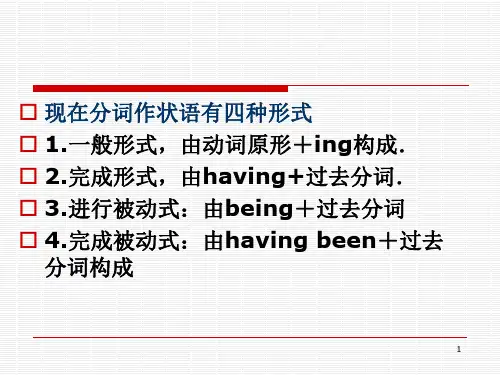


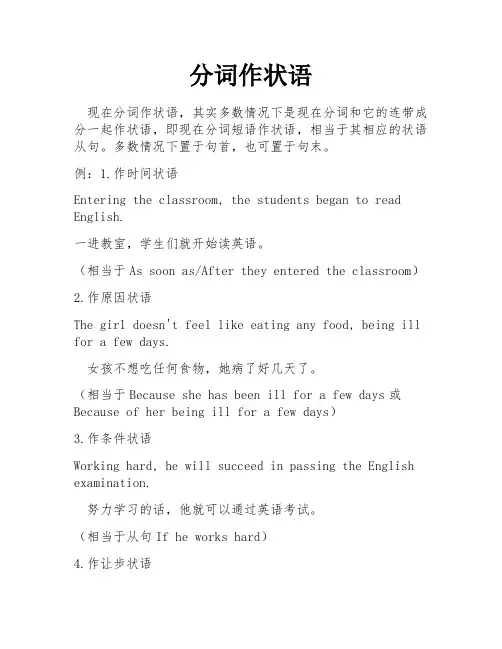
分词作状语现在分词作状语,其实多数情况下是现在分词和它的连带成分一起作状语,即现在分词短语作状语,相当于其相应的状语从句。
多数情况下置于句首,也可置于句末。
例:1.作时间状语Entering the classroom, the students began to read English.一进教室,学生们就开始读英语。
(相当于As soon as/After they entered the classroom)2.作原因状语The girl doesn't feel like eating any food, being ill for a few days.女孩不想吃任何食物,她病了好几天了。
(相当于Because she has been ill for a few days或Because of her being ill for a few days)3.作条件状语Working hard, he will succeed in passing the English examination.努力学习的话,他就可以通过英语考试。
(相当于从句If he works hard)4.作让步状语Being tired after work, he still insists on studying French.下班后很累,他任然坚持学习法语。
(相当于Though he is tired after work或Though tired after work)5.作结果状语People all over the world sing the song, making it popular.全世界的人都唱这首歌,使它流行了起来。
(相当于so that they make it popular)6.作方式状语Travelling by car , we enjoyed many beautifull places.乘车旅行,我们欣赏了很多优美地方。
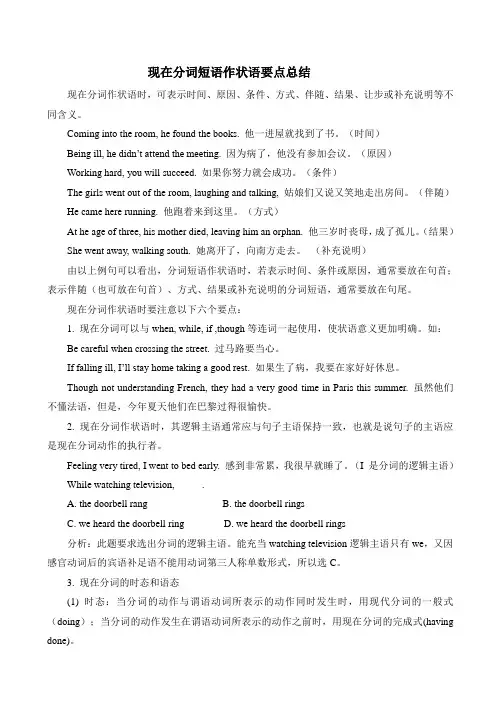
现在分词短语作状语要点总结现在分词作状语时,可表示时间、原因、条件、方式、伴随、结果、让步或补充说明等不同含义。
Coming into the room, he found the books. 他一进屋就找到了书。
(时间)Being ill, he didn’t attend the meeting. 因为病了,他没有参加会议。
(原因)Working hard, you will succeed. 如果你努力就会成功。
(条件)The girls went out of the room, laughing and talking, 姑娘们又说又笑地走出房间。
(伴随)He came here running. 他跑着来到这里。
(方式)At he age of three, his mother died, leaving him an orphan. 他三岁时丧母,成了孤儿。
(结果)She went away, walking south. 她离开了,向南方走去。
(补充说明)由以上例句可以看出,分词短语作状语时,若表示时间、条件或原因,通常要放在句首;表示伴随(也可放在句首)、方式、结果或补充说明的分词短语,通常要放在句尾。
现在分词作状语时要注意以下六个要点:1. 现在分词可以与when, while, if ,though等连词一起使用,使状语意义更加明确。
如:Be careful when crossing the street. 过马路要当心。
If falling ill, I’ll stay home taking a good rest. 如果生了病,我要在家好好休息。
Though not understanding French, they had a very good time in Paris this summer. 虽然他们不懂法语,但是,今年夏天他们在巴黎过得很愉快。
2. 现在分词作状语时,其逻辑主语通常应与句子主语保持一致,也就是说句子的主语应是现在分词动作的执行者。
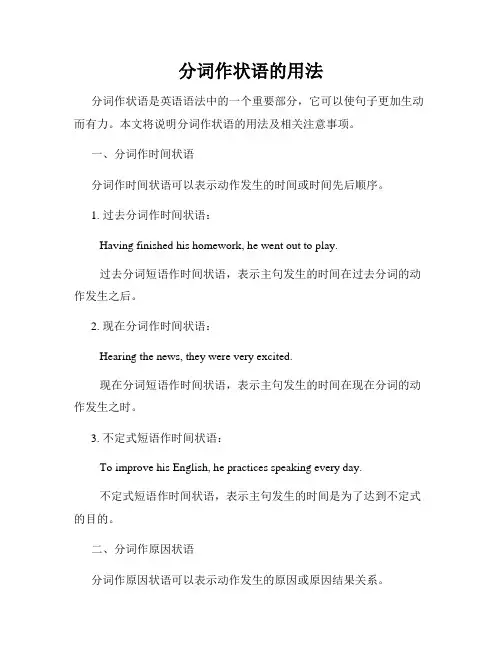
分词作状语的用法分词作状语是英语语法中的一个重要部分,它可以使句子更加生动而有力。
本文将说明分词作状语的用法及相关注意事项。
一、分词作时间状语分词作时间状语可以表示动作发生的时间或时间先后顺序。
1. 过去分词作时间状语:Having finished his homework, he went out to play.过去分词短语作时间状语,表示主句发生的时间在过去分词的动作发生之后。
2. 现在分词作时间状语:Hearing the news, they were very excited.现在分词短语作时间状语,表示主句发生的时间在现在分词的动作发生之时。
3. 不定式短语作时间状语:To improve his English, he practices speaking every day.不定式短语作时间状语,表示主句发生的时间是为了达到不定式的目的。
二、分词作原因状语分词作原因状语可以表示动作发生的原因或原因结果关系。
1. 过去分词作原因状语:Being tired, she decided to go to bed early.过去分词短语作原因状语,表示主句发生的原因是过去分词的动作。
2. 现在分词作原因状语:Seeing the dark clouds, they decided to bring umbrellas.现在分词短语作原因状语,表示主句发生的原因是现在分词的动作。
3. 不定式短语作原因状语:To save money, he stopped eating out.不定式短语作原因状语,表示主句发生的原因是不定式的目的。
三、分词作条件状语分词作条件状语可以表示动作发生的条件或条件结果关系。
1. 过去分词作条件状语:Given the chance, he would travel around the world.过去分词短语作条件状语,表示主句发生的条件是过去分词的动作。
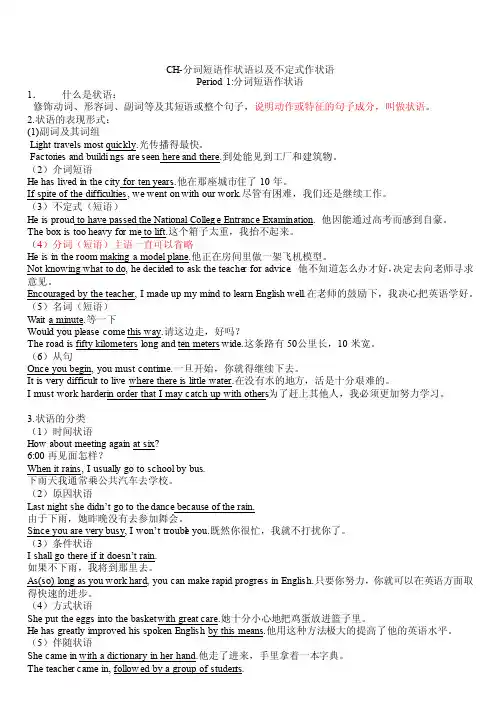
CH-分词短语作状语以及不定式作状语Period1:分词短语作状语1.什么是状语:修饰动词、形容词、副词等及其短语或整个句子,说明动作或特征的句子成分,叫做状语。
2.状语的表现形式:(1)副词及其词组Light travels most quickly.光传播得最快。
Factori es and buildin gs are seen here and there.到处能见到工厂和建筑物。
(2)介词短语He has lived in the city for ten years.他在那座城市住了10年。
If spite of the difficu lties, we went on with our work.尽管有困难,我们还是继续工作。
(3)不定式(短语)He is proud to have passedthe Nationa l College Entranc e Examina tion. 他因能通过高考而感到自豪。
The box is too heavy for me to lift.这个箱子太重,我抬不起来。
(4)分词(短语)主语一直可以省略He is in the room makinga model plane.他正在房间里做一架飞机模型。
Not knowing what to do, he decided to ask the teacher for advice.他不知道怎么办才好,决定去向老师寻求意见。
Encoura ged by the teacher, I made up my mind to learn English well.在老师的鼓励下,我决心把英语学好。
(5)名词(短语)Wait a minute.等一下Would you pleasecome this way.请这边走,好吗?The road is fifty kilomet ers long and ten meterswide.这条路有50公里长,10米宽。
分词作状语的使用技巧分词是英语语法中较为重要的一个部分,分词短语被广泛应用于英语写作中的各个方面,尤其是作状语。
分词短语作为状语的主要作用是修饰谓语动词,并指明动作发生的情况。
以下是分词作状语的使用技巧。
1. 分词短语放在句首或句尾,可以强调该分词短语所表达的含义。
例如:Walking along the street, he suddenly stopped.(他沿街走着,突然停住了。
)2. 如果分词短语和句子主语之间是主动关系,应该使用现在分词;如果分词短语和句子主语之间是被动关系,应该使用过去分词。
例如:The girl sitting next to me is my sister.(坐在我旁边的女孩是我的妹妹。
)I was impressed by the book written by him.(我被他写的那本书打动了。
)3. 如果两个动作同时发生,应该使用现在分词;如果其中一个动作先于另一个动作发生,应该使用过去分词。
例如:Feeling happy, he started to dance.(他感到很开心,开始跳舞了。
)Havingfinished his homework, he went to bed.(他做完作业后,就去睡觉了。
)4. 分词短语作状语时,要注意和谓语动词的时态保持一致。
例如:Having studied English for five years, he has made great progress.(他已经学了五年英语,进展很大。
)总之,分词作状语是英语写作中常用的修辞手段之一。
熟练掌握分词短语的使用技巧,能够使英语写作更加富有变化和表现力。
首先要知道什么是分词。
分词就是动词 ing或 ed的形成,称为现在分词和过去分词.既然分词是由动词变化而来,那么它就继承了动词原有的属性,即:可以带宾语或状语.这就构成了分词短语.分词也称为非谓语动词,不可以作谓语,但可以作定语、状语、补语、表语.下面举例说明:一、分词短语作定语,短语我用括号表示:①The man (standing in front of our classroom)is our headmaster。
站在我们教室前面的那个人是我们的校长。
②The police found the car (stolen from a rich businessman).警察找到了从富商那被盗走的汽车。
二、分词短语作状语:① (Walking in the field),he noticed an unusual flower.正在田野走着,他发现了一种不同寻常的花。
②(Tired of cooking),the Smiths went to a restaurant to have dinner.讨厌做饭,史密斯一家去了饭店吃饭。
三、作补语:① I heard someone (singing loudly outside).我听到外面有人高声唱歌.② I found my room (broken into )。
我发现有人进入过我的房间.四、作表语:① Your story is (quite interesting)。
你的故事很有趣。
② The bridge was (badly damaged in the earthquake)。
桥梁在地震中严重受损. 最后提醒:分词短语作表语与被动语态很相似,容易弄混。
被动语态强调动作,表语强调状态。
状态是持续的,动作是短暂的.CH-分词短语作状语以及不定式作状语Period 1:分词短语作状语1.什么是状语:修饰动词、形容词、副词等及其短语或整个句子,说明动作或特征的句子成分,叫做状语。
过去分词短语作状语的用法过去分词短语作状语的用法有很多,以下是60条以上的例子:1. 修饰动词:- 滑冰时,小明跌倒了。
- 他一边读书,一边写作业。
- 她唱完了歌,向观众鞠躬。
2. 修饰形容词:- 他很困疲,连续工作了十个小时。
- 她非常兴奋,因为她被录取了。
3. 修饰副词:- 他跑得很快,追上了那个小偷。
- 他讲得很认真,大家都很受感动。
4. 表示时间:- 昨天我在图书馆看书。
- 他在军队服役了两年。
5. 表示原因:- 天气太热了,我们决定去游泳。
- 因为过去常常下雨,他没有收获到很多庄稼。
6. 表示结果:- 摔跤后,他的腿受伤了。
- 长时间的用眼使她的视力变差了。
7. 表示条件:- 如果得了好成绩,他们就会给她一个奖学金。
- 假如你赢了比赛,我会带你去庆祝。
8. 表示让步:- 尽管难以置信,他们完成了任务。
- 即使生活各方面都很困难,他也从未放弃。
9. 表示方式:- 他小声地说,以免被听到。
- 警察把他粗暴地逮捕起来。
10. 表示伴随:- 我们一起坐在海滩上看着日落。
- 在音乐声中,他们舞蹈了一整晚。
11. 表示目的:- 他去邮局寄信。
- 我们买了一些食物,为了备不时之需。
12. 表示程度:- 晚餐做得很好,大家都吃得很饱。
- 雨下得很大,我们都淋湿了。
13. 表示顺序:- 他按照指示一步一步地进行。
- 他按照说明书安装了电视。
14. 表示比较:- 她比我学得更快。
- 这部电影比预期更好看。
15. 表示条件:- 假如你想要通过考试,你就需要努力学习。
- 如果下雨,我们就会取消野餐计划。
16. 表示结果:- 失去工作,他变得沮丧。
- 她的努力得到了回报。
17. 表示时间:- 经历了许多困难,他终于实现了梦想。
- 她看了一会电视,然后出去散步。
18. 表示原因:- 由于道路交通拥堵,我们迟到了。
- 风大得让树都被吹倒了。
19. 表示让步:- 尽管工作很忙,他还是找时间陪孩子。
- 即使受伤了,他仍然坚持比赛。
分词短语作时间状语详细时间状语是用来表示动作发生的时间的词语,分词短语作为时间状语可以更加丰富句子的表达。
本文将详细介绍分词短语作时间状语的使用方法。
一、分词短语作时间状语的定义分词短语是由动词的现在分词或过去分词形式构成的短语。
当分词短语用来表示动作发生的时间时,可以作为时间状语,用于修饰主句中的动作。
二、分词短语作时间状语的分类分词短语作时间状语可以分为以下几种情况:1. 过去分词作时间状语过去分词表示的动作发生在主句谓语动词之前。
常见的过去分词作时间状语的情况有:- Having finished his homework, he went to bed.(完成作业后,他上床睡觉。
)- Being tired, she decided to take a break.(因为疲劳,她决定休息一下。
)2. 现在分词作时间状语现在分词表示的动作与主句谓语动词同时进行。
常见的现在分词作时间状语的情况有:- Watching TV, he fell asleep.(看电视时,他睡着了。
)- Playing in the park, the children were having fun.(孩子们在公园里玩得很开心。
)3. 否定分词作时间状语否定分词表示的动作是主句谓语动词之前或同时发生的动作,其否定含义与主句的动作相对。
常见的否定分词作时间状语的情况有:- Not knowing the answer, he asked for help.(不知道答案,他请求帮助。
)- Without saying a word, she left the room.(没有说一句话,她离开了房间。
)三、分词短语作时间状语的注意事项在使用分词短语作时间状语时,需要注意以下几点:1. 分词短语要能够与主句的主语或宾语保持逻辑上的一致性。
2. 分词短语作时间状语应放在句子开头或结尾,以便清楚修饰整个句子。
3. 分词短语作时间状语时,注意与主句的时间关系,选择适当的分词形式。
现在分词作状语举例说明
分词作状语,是指分词(动词的现在分词形式或过去分词形式)在句中充当状语,修饰主句的谓语动词,表示时间、原因、条件、方式等等。
以下是一些例子:
1. 时间状语:Having finished my homework, I went out for a walk. (我做完作业后,出去散步了。
)
在这个句子中,动词分词短语“Having finished my homework”作时间状语,说明主句中的动作发生在前一个动作完成之后。
2. 原因状语:Being tired, she decided to go to bed early. (她因为累了,决定早点睡觉。
)
在这个句子中,动词分词短语“Being tired”作原因状语,解释了为什么她要早点睡觉。
3. 条件状语:If invited, I will attend the party. (如果被邀请,我会参加派对。
)
在这个句子中,动词过去分词短语“If invited”作条件状语,表示只有在被邀请的情况下,我才会去参加派对。
4. 方式状语:He drove to work, singing loudly all the way. (他一路上唱着大声的歌开车去上班。
)
在这个句子中,动词分词短语“singing loudly”作方式状语,说明他开车去上班的方式。
这些例子展示了分词作状语的不同用法。
需要注意的是,分词作状语时一般放在句子的前面或者后面,如果在句子的前面,要用逗号将其与主句分开。
首先要知道什么是分词.分词就是动词 ing或 ed的形成,称为现在分词和过去分词.既然分词是由动词变化而来,那么它就继承了动词原有的属性,即:可以带宾语或状语.这就构成了分词短语.分词也称为非谓语动词,不可以作谓语,但可以作定语、状语、补语、表语.下面举例说明:一、分词短语作定语,短语我用括号表示:①The man (standing in front of our classroom)is our headmaster.站在我们教室前面的那个人是我们的校长.②The police found the car (stolen from a rich businessman).警察找到了从富商那被盗走的汽车.二、分词短语作状语:①(Walking in the field),he noticed an unusual flower.正在田野走着,他发现了一种不同寻常的花.②(Tired of cooking),the Smiths went to a restaurant to have dinner.讨厌做饭,史密斯一家去了饭店吃饭.三、作补语:① I heard someone (singing loudly outside).我听到外面有人高声唱歌.② I found my room (broken into ).我发现有人进入过我的房间.四、作表语:① Your story is (quite interesting).你的故事很有趣.② The bridge was (badly damaged in the earthquake).桥梁在地震中严重受损. 最后提醒:分词短语作表语与被动语态很相似,容易弄混.被动语态强调动作,表语强调状态.状态是持续的,动作是短暂的.CH-分词短语作状语以及不定式作状语Period 1:分词短语作状语1.什么是状语:修饰动词、形容词、副词等及其短语或整个句子,说明动作或特征的句子成分,叫做状语。
2.状语的表现形式:(1)副词及其词组Light travels most quickly.光传播得最快。
Factories and buildings are seen here and there.到处能见到工厂和建筑物。
(2)介词短语He has lived in the city for ten years.他在那座城市住了10年。
If spite of the difficulties, we went on with our work.尽管有困难,我们还是继续工作。
(3)不定式(短语)He is proud to have passed the National College Entrance Examination. 他因能通过高考而感到自豪。
The box is too heavy for me to lift.这个箱子太重,我抬不起来。
(4)分词(短语)主语一直可以省略He is in the room making a model plane.他正在房间里做一架飞机模型。
Not knowing what to do, he decided to ask the teacher for advice. 他不知道怎么办才好,决定去向老师寻求意见。
Encouraged by the teacher, I made up my mind to learn English well.在老师的鼓励下,我决心把英语学好。
(5)名词(短语)Wait a minute.等一下Would you please come this way.请这边走,好吗?The road is fifty kilometers long and ten meters wide.这条路有50公里长,10米宽。
(6)从句Once you begin, you must continue.一旦开始,你就得继续下去。
It is very difficult to live where there is little water.在没有水的地方,活是十分艰难的。
I must work harder in order that I may catch up with others.为了赶上其他人,我必须更加努力学习。
3.状语的分类(1)时间状语How about meeting again at six?6:00再见面怎样?When it rains, I usually go to school by bus.下雨天我通常乘公共汽车去学校。
(2)原因状语Last night she didn’t go to the dance because of the rain.由于下雨,她昨晚没有去参加舞会。
Since you are very busy, I won’t trouble you.既然你很忙,我就不打扰你了。
(3)条件状语I shall go there if it doesn’t rain.如果不下雨,我将到那里去。
As(so) long as you work hard, you can make rapid progress in English.只要你努力,你就可以在英语方面取得快速的进步。
(4)方式状语She put the eggs into the basket with great care.她十分小心地把鸡蛋放进篮子里。
He has greatly improved his spoken English by this means.他用这种方法极大的提高了他的英语水平。
(5)伴随状语She came in with a dictionary in her hand.他走了进来,手里拿着一本字典。
The teacher came in, followed by a group of students.老师走了进来,后面跟着一群学生。
(6)目的状语I went there to see a friend of mine.我去哪里去看我的一个朋友。
Bring it closer so that I may see it better.把它那近些,以便我可以看得更清楚。
(7)结果状语He was so tired that he fell asleep immediately.他累极了,立刻就睡着了。
He is so good a teacher that the students love and respect him.他是一位很好的老师,学生们都敬爱他。
(8)让步状语She worked very hard though she is old.虽然她年纪大了,但她工作仍然十分努力。
No matter when you come, you are warmly welcome.不管你什么时候来,你都会受到热烈欢迎。
(9)程度状语They were greatly moved to hear the hero’s story.听了英雄的故事,他们深受感动。
I quite agree with you.我完全同意你的意见。
(10)比较状语I am taller than he is.我比他高。
The more I speak English, the better I’ll be.我英语讲得越多,就讲得越好。
4.分词短语作状语的用法(高考重点)(1)分词短语做状语的句法功能分词或分词短语作状语时,可以表时间、原因、结果、条件、让步、行为方式、伴随状况等。
表示时间关系的分词短语有时可由连词while或when引出。
Hearing the news, they got excited.(时间)听到这个消息,他们很兴奋。
Be careful while/when crossing the street.(时间) 过街口时,一定要小心。
Having been bitten by a snake, she was frightened at it.(原因)由于被蛇咬过,她很怕蛇。
Given a chance, I can surprise the world.(条件)给我一个机会,我会让世界惊奇。
The cup dropped to the ground, breaking into pieces.(结果) 茶杯掉在地上,摔成了碎片。
Having been told many times, he still repeated the same mistake.(让步) 被告诉了很多次,他仍旧犯同样的错误。
The teacher came into the lab, followed by some students.(伴随状况)老师走进实验室,后面跟着一些学生。
(2)分词短语作状语的形式有以下五种:形式意义doing与句中的主语构成逻辑上的主谓关系,与句中的谓语动词同时发生,或基本上同时发生意思是1)表主动 2)表同时进行(与,或)having done与句中的主语构成逻辑上的主谓关系,先于谓语动词发生意思是1)表主动 2)表先于“主句”谓语动词发生being done与句中的主语构成逻辑上的动宾关系,且与谓语动词同时发生,一般做原因状语置于句首意思是1)表被动 2)表同时进行done与句中的主语构成逻辑上的动宾关系意思是1)表被动 2)表完成(与,或)having been done与句中主语构成逻辑上的动宾关系,且先于谓语动词发生。
意思是1)表被动2)表先于“主句”谓语动词发生练习分析:1. D to get a ticket for the 2008 Olympic Games, George has been standingin a queue for two days.A.Determing be determined C. To determine D. Determined分析:方法一(打回原形)来源句型 Sb is determined to do sth, 这里的determined 是个形容词,来源于过去分词determined,我们说过所有的分词都可以当做形容词来看待。
现在我们把这里的determined当做它的本源过去分词看待。
这句话就等于:After George is determined to get a ticket for the 2008 Olympic Games, George has been standing in a queue for two days.去掉连词after,相同的主语George,去掉be动词Determined to get a ticket for the 2008 Olympic Games, George has been standing in a queue for two days.这里的determined来源于be determined,是被动语态的分词,直接用就可以了,既然已经是分词了,我们就不需要做任何变化了。